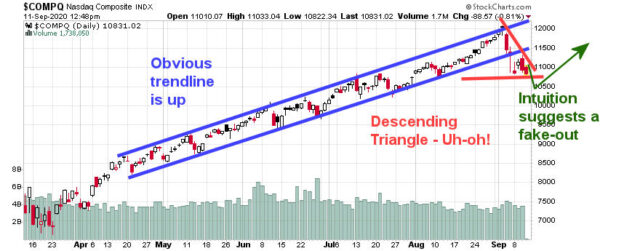Putting it mildly, things are not going to end well. Whatever party ends up in power after the (guessing there is a good chance of this happening) November election is going to face one hell of a mess to clean up. The accumulation of debt and government entitlements will be sucking up private sector capital like a vacuum and this will result in a lowered standard of living for most in the country. It is going to be very difficult to unwind the existing entitlements, including the emergency programs, without a lot of pain. Perhaps this was the intention – to accelerate the economic collapse of the real economy (note: this is not the financial economy, which is an entirely different beast).
For instance, ask yourself why anybody at or under the $15/hour pay bracket would bother working under CERB? Working is effectively taxed at 100% of marginal income for these people. This affects the real economy, specifically the availability of low cost labour. Even middle-class labour (e.g. the $25-$30/hour bracket) has a significant marginal tax (financially, the after-tax amount one gains for spending the time is a minimal wage). The only solace is that the elements of the real economy that have been affected (restaurants, retail, tourism) are not apparently critical to the functioning of the economy.
However, this will be a “canary in the coal mine” type environment. Have any of you gone to the west coast of Newfoundland and looked at the near-ghost towns that are along the coast, most of which had their glory years decades ago when there was a thriving cod fishing industry? The first types of businesses that leave these towns are the ones that thrive on disposable surplus income. After that, other pillars go. Eventually what remains is government – hospitals, schools and city hall, but as the tax base shrinks and people emigrate, this goes as well.
The core industries that produce wealth, farming, forestry, mining (mineral and petroleum), and now to a much lesser degree, fishing, ultimately sustain the rest of it. Another major industry, the export of land titles, is also popular, but there are limitations.
The Bank of Canada confirmed on September 9 that they will be keeping rates low for a very long time, and their version of quantitative easing, $5 billion a week, which works out to a cool $260 billion/year.
QE is a conversion of long-dated maturities (held by the central bank) for short-term liquidity (held by the financial sector or whoever was the counter-party to the bond purchases). It inflates the financial economy, but it is at the expense of earning a return on investment. It also has the consequence of widening the wealth gap and this creates political problems.
Fiscally, the Government of Canada is blowing out gigantic amounts of money out the door and hoping it will reignite a flurry of economic activity and keeping away food riots and other political issues that come with economic upheaval while they figure out what the heck to do. The government can afford to do this because the Bank of Canada is supporting the activity (interest rates are being held very low), in addition to the perception that Canada still has real economic output (which buoys the Canadian dollar – relative to America, we are doing quite well). Despite the Liberal government trying to destroy one of our major industries (energy), we still produce a lot of it. And hypocritically, Trans-Mountain is being constructed by the same government and Coastal Gaslink is progressing.
The short-term effect of this fiscal stimulus will be to keep things afloat. Indeed, you can see evidence of this in the vehicle market, where people are using their new-found wealth to purchase vehicles. There is evidence of other such buying elsewhere.
The issue is that this is going to be transitory. There will certainly be a “feel good” effect to injecting $300 billion into the economy, but it will not be able to last – it will break when capital allocators cannot obtain a proper return on their investments. There are a few economic scenarios that may play out, but two likely ones are we end up in a debt-ridden deflation coupled with economic stagnation for a long period of time (the only escape is significantly long periods of austerity to restore the balance sheet), or we get governments that will fund government spending directly from central banks, which in that case we get serious amounts of inflation (in addition to interest rates skyrocketing). There are other scenarios that may come out of this, but most routes are going to involve pain.
Finally, every province in the country is incurring a massive deficit. Unlike the federal government, provincial governments cannot print their own currency. Taking the inflation route is not an option – they have to go along with whatever the federal government decides.
The Liberals full well know the withdrawal pains from the binge of QE and deficit spending will be coming soon, which is why they are trying to buy themselves another year with an election. Even if the result is status-quo (plurality of seats; minority) they have bought themselves time.

